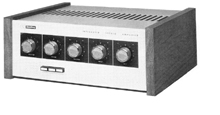 |
Armstrong Integrated stereo amplifier Model 221 |
|
The Armstrong 221 amplifier is essentially the same as the Model 222 all-valve amplifier (reviewed in October 1964) with the addition of transistor booster stages for a low sensitivity magnetic pickup and a few other important refinements. Indeed a common instruction booklet is supplied for the two amplifiers, the 222 continuing to be marketed for users of ceramic cartridges (pickup input rating 80mV at 2 Megohms). Both versions are available in chassis form or in teak cases for freestanding on a shelf. The smart styling of the current range of Armstrong units has won them a Design Centre selection. The grey, silver ringed control knobs are each mounted at the centre of a greenish grey square on the front panel. There are five knobs to control input selection, volume, balance, treble and bass. Three push buttons are provided on the Model 221. The first introduces a 'loudness' contour—that is the extreme bass and treble frequencies are raised in relative level to give a more balanced sound spectrum at low listening levels: the second is labelled "Monitor" and is intended for use with tape recording equipment which provides a 'monitor' output from the tape. There is an auxiliary tape monitor input for this purpose, and the push-button permits instantaneous comparison (through the Model 221 and its loudspeakers) of the input signal and that recorded on the tape. The third push- button introduces a treble filter giving a 12dB per octave cut above 8 Kc/s. The remainder of the controls are common to the Models 221 and 222 and include a rumble filter slide switch (at the rear of the chassis). The extra stages of the Model 221 are mounted on a single printed circuit board adjacent to the input selector switch and comprise a pair of BC107 transistors in each channel. A sensitivity of 3.5mV at 50 K is achieved, the boosted signal being fed in parallel with the standard high impedance pickup inlet sockets. The amplifier proper employs an ECC83 double triode and two ECL86 triode-pentodes in each channel and was fully described in the earlier review. The amplifier was found simple to set up and use, and listening tests with good quality loud-speakers and a variety of inputs including magnetic and ceramic cartridges soon proved it to be capable of very good reproduction. The bass and treble controls gave reasonable, if not drastic, boost and cut: the HF filter was adequate for noisy discs without being sharp enough to act as an old-fashioned 'scratch filter': the LF filter was more gradual than one would like, bearing in mind that the most important use for such a filter is to reduce motor rumble on medium- or low-priced gramophone turntables—and for this a sharp cut off below about 30 c/s is preferred. Exhaustive measurements were made of all modes of operation, the functions which are common to the Model 222 being found to match those in the earlier review. As with the previous unit, the treble control had to be advanced slightly from the mid-position; this done the response was substantially flat, corresponding to the claimed ±1dB from 30 to 20,000 c/s. Bass control range was ± 11dB at 70 c/s; treble control was +14dB, -9dB at 10 Kc/s. The LF filter produced 6dB attenuation at 35 c/s as claimed, but with a fairly gradual slope; the HF filter operated at the 8 Kc/s turnover frequency with a slope of about 12dB per octave. The performances of the left and right channels were within 1dB throughout, as was checked by plotting each response separately and laying one graph over the other. Crosstalk and noise were commendably low, being -50dB at 1 Kc/s and -54dB relative to the rated output, respectively. On the magnetic pickup input, signal-to-noise ratio was 43dB using a Decca ffss Mk. Ill pickup as load. This form of loading was chosen to simulate working conditions, and a figure several decibels better would be expected if spurious hum pickup, etc., were allowed for. The total harmonic distortion was 0.2% at 5 Watts, 0.7% at 8 Watts, and 1.2% at 9 Watts. The Armstrong Model 221 gave a good account of
itself during extended periods of listening to records and radio.
It is smart in appearance and with average or even low efficiency
loudspeakers will supply ample power for living room listening.
The extra price, compared with the Model 222, is fully justified
for anyone intending to use a low output magnetic pickup cartridge
either now or in the future. |
|||
 Taken
from 'The Gramophone' February 1966
Taken
from 'The Gramophone' February 1966